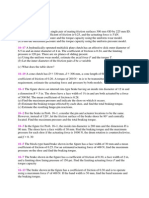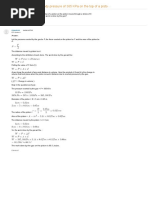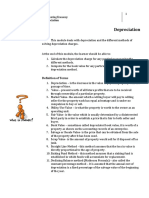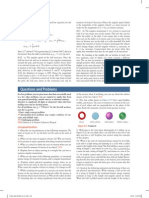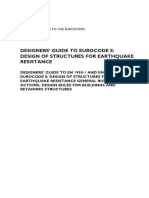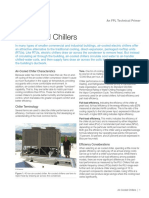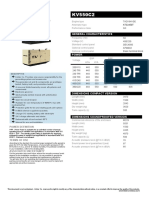Tutorial2 Solved SDOF
Uploaded by
Ulrich Simo DomguiaTutorial2 Solved SDOF
Uploaded by
Ulrich Simo DomguiaTutorials_Chapter2_MEF365
Free vibration of undamped translational and rotational systems
Exercise 1
1. An industrial press is mounted on a rubber pad to isolate it from its foundation. If the rubber pad
is compressed 5 mm by the self weight of the press, find the natural frequency of the system.
2. A spring-mass system has a natural period of 0.21 sec. What will be the new period if the spring
constant is (a) increased by 50 percent and (b) decreased by 50 percent?
3. A spring-mass system has a natural frequency of 10 Hz. When the spring constant is reduced
by 800 N/m, the frequency is altered by 45 percent. Find the mass and spring constant of the
original system.
4. A helical spring, when fixed at one end and loaded at the other, requires a force of 100 N to
produce an elongation of 10 mm. The ends of the spring are now rigidly fixed, one end vertically
above the other, and a mass of 10 kg is attached at the middle point of its length. Determine the
time taken to complete one vibration cycle when the mass is set vibrating in the vertical direction.
Exercise 2
The maximum velocity attained by the mass of a simple harmonic oscillator is 10 cm/s, and the
period of oscillation is 2 s. If the mass is released with an initial displacement of 2 cm, find (a) the
amplitude, (b) the initial velocity, (c) the maximum acceleration, and (d) the phase angle.
Exercise 3
Three springs and a mass are attached to a rigid, weightless bar PQ as shown in Fig.1. Find the
natural frequency of vibration of the system.
Figure 1 Figure 2
Dr. SIMO Ulrich_Lecturer_UB / MECHANICAL VIBRATIONS – TUTORIALS -- CHAPTER 2
Exercise 4
1. An automobile having a mass of 2,000 kg deflects its suspension springs 0.02 m under
static conditions. Determine the natural frequency of the automobile in the vertical
direction by assuming damping to be negligible.
2. Find the natural frequency of vibration of a spring-mass system arranged on an inclined
plane, as shown in Fig. 2.
Exercise 5
1. Find the natural frequency of the pulley system shown in Fig.3 by neglecting the friction
and the masses of the pulleys.
2. A weight W is supported by three frictionless and massless pulleys and a spring of stiffness
k, as shown in Fig.4. Find the natural frequency of vibration of weight W for small
oscillations.
3. A rigid block of mass M is mounted on four elastic supports, as shown in Fig. 5. A mass m
drops from a height l and adheres to the rigid block without rebounding. If the spring
constant of each elastic support is k, find the natural frequency of vibration of the system
(a) without the mass m, and (b) with the mass m. Also find the resulting motion of the
system in case (b).
Figure 4
Figure 3
Figure 5
Dr. SIMO Ulrich_Lecturer_UB / MECHANICAL VIBRATIONS – TUTORIALS -- CHAPTER 2
Exercise 6
Figure 6 shows a small mass m restrained by four linearly elastic springs, each of which has an
unstretched length l, and an angle of orientation of 45o with respect to the x-axis. Determine the
equation of motion for small displacements of the mass in the x direction
Figure 6
Exercise 7
Derive the equation of motion of the system shown in Fig. 7, using the following methods: (a)
Newton’s second law of motion, (b) Lagrange’s equations.
Draw the free-body diagram and derive the equation of motion using Newton’s second law of
motion for each of the systems shown in Figs. 8 and 9
Figure 7
Figure 9
Figure 8
Dr. SIMO Ulrich_Lecturer_UB / MECHANICAL VIBRATIONS – TUTORIALS -- CHAPTER 2
Exercise 8
A uniform slender rod of mass m and length l is hinged at point A and is attached to four linear
springs and one torsional spring, as shown in Fig. 10. Find the natural frequency of the system if
k = 2000 N/m, kt = 1000 Nm/rad, m = 10 kg and l = 5 m.
Figure 10
Response of first-order systems and time constant
Exercise 9
Find the free-vibration response and the time constant, where applicable, of systems governed by
the following equations of motion:
Hint: The time constant can also be defined as the value of time at which the step response of a
system rises to 63.2% (100.0% - 36.8) of its final value.
Dr. SIMO Ulrich_Lecturer_UB / MECHANICAL VIBRATIONS – TUTORIALS -- CHAPTER 2
Free vibration with Viscous damping
Exercise 10
Derive the equation of motion and find the natural frequency of vibration of each of the systems
shown in Figs. 11 to 13.
Figure 12
Figure 11
Figure 13
Exercise 11
Forced vibration (Damped and Undamped systems under Harmonic force)
Exercise 12
A weight of 50 N is suspended from a spring of stiffness 4000 N/m and is subjected to a harmonic
force of amplitude 60 N and frequency 6 Hz. Find (a) the extension of the spring due to the
suspended weight, (b) the static displacement of the spring due to the maximum applied force, and
(c) the amplitude of forced motion of the weight.
Dr. SIMO Ulrich_Lecturer_UB / MECHANICAL VIBRATIONS – TUTORIALS -- CHAPTER 2
Exercise 13
Consider a spring-mass system, with k = 4000 N/m and m = 10 kg, subject to a harmonic force
F (t ) = 400cos10t (N). Find and plot the total response of the system under the following initial
conditions:
Exercise 14
Derive the equation of motion and find the steady-state response of the system shown in Fig. 14
for rotational motion about the hinge O for the following data: k1 = k2 = 5000 N/m, a = 0.25 m, b
= 0.5 m, l = 1 m, M = 50 kg, m = 10 kg, F0 = 500 N, w = 1000 rpm.
Figure 14
Exercise 15
For the system shown in Fig. 15, x and y denote, respectively, the absolute displacements of the
mass m and the end Q of the dashpot c1. (a) Derive the equation of motion of the mass m, (b) find
the steady-state displacement of the mass m, and (c) find the force transmitted to the support at P,
when the end Q is subjected to the harmonic motion y(t) = Y*cos(wt).
Figure 15
Dr. SIMO Ulrich_Lecturer_UB / MECHANICAL VIBRATIONS – TUTORIALS -- CHAPTER 2
You might also like
- High Pressure Turbine Governing System PDF100% (7)High Pressure Turbine Governing System PDF28 pages
- CH 03c, Coulomb Damping in Free Vibration of SDOFNo ratings yetCH 03c, Coulomb Damping in Free Vibration of SDOF10 pages
- Vibration - Introduction3 - Damped VibrationNo ratings yetVibration - Introduction3 - Damped Vibration22 pages
- Homework Mechatronic Chapter 7,8,9 (Fatahul Arifin)No ratings yetHomework Mechatronic Chapter 7,8,9 (Fatahul Arifin)5 pages
- Problem Set 4 - Differential Equation-Probabilty and StatisticsNo ratings yetProblem Set 4 - Differential Equation-Probabilty and Statistics2 pages
- University of Rizal System: Electro-Mechanical Energy Conversion (EE 4) (For Completion)No ratings yetUniversity of Rizal System: Electro-Mechanical Energy Conversion (EE 4) (For Completion)9 pages
- Physics II Sheet 2 - Chapter Two - Part 1 Dr. Yasmeen H.AbedNo ratings yetPhysics II Sheet 2 - Chapter Two - Part 1 Dr. Yasmeen H.Abed8 pages
- Control Systems Lab 1 Linear Control System: Submitted To: Dr. Haris Awan Date: Submitted byNo ratings yetControl Systems Lab 1 Linear Control System: Submitted To: Dr. Haris Awan Date: Submitted by14 pages
- A Gas Exerts A Steady Pressure of 385 KPa On The T...0% (1)A Gas Exerts A Steady Pressure of 385 KPa On The T...1 page
- 5 Practice Problem Control Volume Approach and Continuity Principle100% (1)5 Practice Problem Control Volume Approach and Continuity Principle12 pages
- Intoduction of The Concepts of Kinematics MachineriesNo ratings yetIntoduction of The Concepts of Kinematics Machineries8 pages
- Exercises On Air Conditioning Processes (Solutions) Week 9No ratings yetExercises On Air Conditioning Processes (Solutions) Week 99 pages
- Problem Set 2 Velocity and Accelaration MethodNo ratings yetProblem Set 2 Velocity and Accelaration Method11 pages
- ME34ME505 - Vibration and Noise ControlPractice Problems INo ratings yetME34ME505 - Vibration and Noise ControlPractice Problems I20 pages
- Negative Mass and Negative Refractive Index in Atom Nuclei - Nuclear Wave Equation - Gravitational and Inertial Control: Part 6: Gravitational and Inertial Control, #6From EverandNegative Mass and Negative Refractive Index in Atom Nuclei - Nuclear Wave Equation - Gravitational and Inertial Control: Part 6: Gravitational and Inertial Control, #6No ratings yet
- Negative Mass and Negative Refractive Index in Atom Nuclei - Nuclear Wave Equation - Gravitational and Inertial Control: Part 5: Gravitational and Inertial Control, #5From EverandNegative Mass and Negative Refractive Index in Atom Nuclei - Nuclear Wave Equation - Gravitational and Inertial Control: Part 5: Gravitational and Inertial Control, #5No ratings yet
- Activity I: Ceramics: Callister, 7th Edition. The Periodic Table of The ElementsNo ratings yetActivity I: Ceramics: Callister, 7th Edition. The Periodic Table of The Elements3 pages
- Pre Activity: Review of Grains, Grain Boundaries, and DislocationsNo ratings yetPre Activity: Review of Grains, Grain Boundaries, and Dislocations4 pages
- Loads and Forces Acting On Retaining Wall and Their Calculat (PDF)No ratings yetLoads and Forces Acting On Retaining Wall and Their Calculat (PDF)6 pages
- Finite Element Simulation of Single-Lap Shear Tests Utilizing TheNo ratings yetFinite Element Simulation of Single-Lap Shear Tests Utilizing The51 pages
- Traction Planes of Differing Orientations: ! dF/dANo ratings yetTraction Planes of Differing Orientations: ! dF/dA5 pages
- Title: Automotive Powertrain Date: Objective: To Understand The Power Train Components of Automobiles BothNo ratings yetTitle: Automotive Powertrain Date: Objective: To Understand The Power Train Components of Automobiles Both6 pages
- Experiment No. 6-Study of The Constructional Features and Working of Pelton TurbineNo ratings yetExperiment No. 6-Study of The Constructional Features and Working of Pelton Turbine7 pages
- New JSME Standard S008 Performance Conversion MethNo ratings yetNew JSME Standard S008 Performance Conversion Meth11 pages
- FPT-IVECO-USE-AND-MAINTENANCE-CURSOR-SERIESNo ratings yetFPT-IVECO-USE-AND-MAINTENANCE-CURSOR-SERIES25 pages
- GoPV 1sttraining Tracker Design 1st PartNo ratings yetGoPV 1sttraining Tracker Design 1st Part47 pages
- AUMAR AL MESHHADANY - Experiment 3 - Lab DI-XNo ratings yetAUMAR AL MESHHADANY - Experiment 3 - Lab DI-X20 pages
- Designers' Guide To Eurocode 8: Design of Structures For Earthquake ResistanceNo ratings yetDesigners' Guide To Eurocode 8: Design of Structures For Earthquake Resistance288 pages
- The Northridge Connection Studies SAC Joint VentureNo ratings yetThe Northridge Connection Studies SAC Joint Venture12 pages
- Cherry 1900 Bulbing Blind Rivet: SPS Fastener Division, ANo ratings yetCherry 1900 Bulbing Blind Rivet: SPS Fastener Division, A4 pages
- Set Timing Engine - Mechanical - 5s-Fe-2No ratings yetSet Timing Engine - Mechanical - 5s-Fe-22 pages
- MANUFACTURING TECHNOLOGY ASSIGNMENT (Bahirdar University)No ratings yetMANUFACTURING TECHNOLOGY ASSIGNMENT (Bahirdar University)18 pages
- Mechanical Smoke Ventilation Calculations For Basement (Car Park)No ratings yetMechanical Smoke Ventilation Calculations For Basement (Car Park)7 pages
- Homework Mechatronic Chapter 7,8,9 (Fatahul Arifin)Homework Mechatronic Chapter 7,8,9 (Fatahul Arifin)
- Problem Set 4 - Differential Equation-Probabilty and StatisticsProblem Set 4 - Differential Equation-Probabilty and Statistics
- University of Rizal System: Electro-Mechanical Energy Conversion (EE 4) (For Completion)University of Rizal System: Electro-Mechanical Energy Conversion (EE 4) (For Completion)
- Physics II Sheet 2 - Chapter Two - Part 1 Dr. Yasmeen H.AbedPhysics II Sheet 2 - Chapter Two - Part 1 Dr. Yasmeen H.Abed
- Control Systems Lab 1 Linear Control System: Submitted To: Dr. Haris Awan Date: Submitted byControl Systems Lab 1 Linear Control System: Submitted To: Dr. Haris Awan Date: Submitted by
- A Gas Exerts A Steady Pressure of 385 KPa On The T...A Gas Exerts A Steady Pressure of 385 KPa On The T...
- 5 Practice Problem Control Volume Approach and Continuity Principle5 Practice Problem Control Volume Approach and Continuity Principle
- Intoduction of The Concepts of Kinematics MachineriesIntoduction of The Concepts of Kinematics Machineries
- Exercises On Air Conditioning Processes (Solutions) Week 9Exercises On Air Conditioning Processes (Solutions) Week 9
- ME34ME505 - Vibration and Noise ControlPractice Problems IME34ME505 - Vibration and Noise ControlPractice Problems I
- Negative Mass and Negative Refractive Index in Atom Nuclei - Nuclear Wave Equation - Gravitational and Inertial Control: Part 6: Gravitational and Inertial Control, #6From EverandNegative Mass and Negative Refractive Index in Atom Nuclei - Nuclear Wave Equation - Gravitational and Inertial Control: Part 6: Gravitational and Inertial Control, #6
- Negative Mass and Negative Refractive Index in Atom Nuclei - Nuclear Wave Equation - Gravitational and Inertial Control: Part 5: Gravitational and Inertial Control, #5From EverandNegative Mass and Negative Refractive Index in Atom Nuclei - Nuclear Wave Equation - Gravitational and Inertial Control: Part 5: Gravitational and Inertial Control, #5
- Activity I: Ceramics: Callister, 7th Edition. The Periodic Table of The ElementsActivity I: Ceramics: Callister, 7th Edition. The Periodic Table of The Elements
- Pre Activity: Review of Grains, Grain Boundaries, and DislocationsPre Activity: Review of Grains, Grain Boundaries, and Dislocations
- Loads and Forces Acting On Retaining Wall and Their Calculat (PDF)Loads and Forces Acting On Retaining Wall and Their Calculat (PDF)
- Finite Element Simulation of Single-Lap Shear Tests Utilizing TheFinite Element Simulation of Single-Lap Shear Tests Utilizing The
- Traction Planes of Differing Orientations: ! dF/dATraction Planes of Differing Orientations: ! dF/dA
- Title: Automotive Powertrain Date: Objective: To Understand The Power Train Components of Automobiles BothTitle: Automotive Powertrain Date: Objective: To Understand The Power Train Components of Automobiles Both
- Experiment No. 6-Study of The Constructional Features and Working of Pelton TurbineExperiment No. 6-Study of The Constructional Features and Working of Pelton Turbine
- New JSME Standard S008 Performance Conversion MethNew JSME Standard S008 Performance Conversion Meth
- Designers' Guide To Eurocode 8: Design of Structures For Earthquake ResistanceDesigners' Guide To Eurocode 8: Design of Structures For Earthquake Resistance
- The Northridge Connection Studies SAC Joint VentureThe Northridge Connection Studies SAC Joint Venture
- Cherry 1900 Bulbing Blind Rivet: SPS Fastener Division, ACherry 1900 Bulbing Blind Rivet: SPS Fastener Division, A
- MANUFACTURING TECHNOLOGY ASSIGNMENT (Bahirdar University)MANUFACTURING TECHNOLOGY ASSIGNMENT (Bahirdar University)
- Mechanical Smoke Ventilation Calculations For Basement (Car Park)Mechanical Smoke Ventilation Calculations For Basement (Car Park)




















